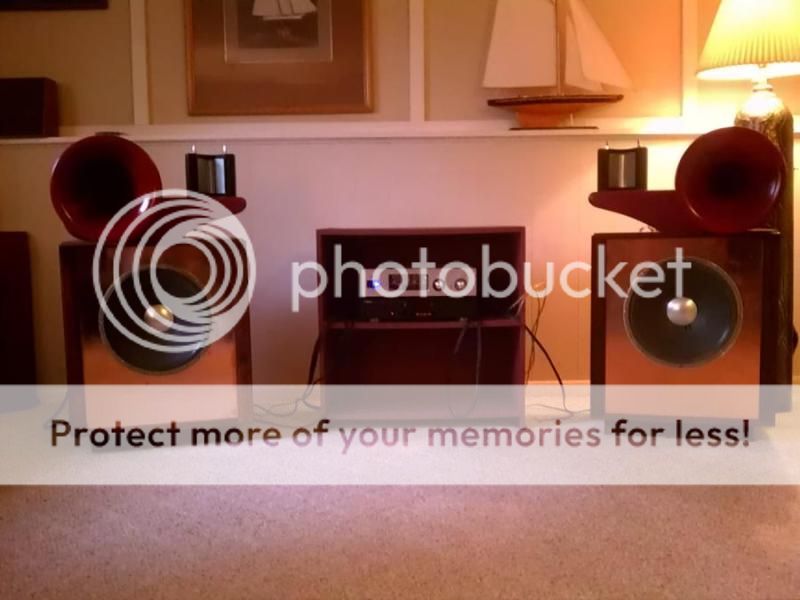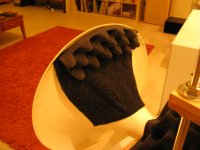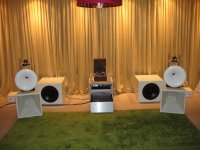Looking good! Here's a small hint: I'd suggest moving the horns just a little higher, so there's 2" or so of clearance between the edge of the AH425 and the top of the bass cabinets. The LeCleac'h seems to like having a bit of free space around the edge of the horn-mouth. Many horns of the low-diffraction type seem to like a bit of free space around the horn-mouth.
Similarly, put some damping material (like Bonded Logic UltraTouch damping pads made from recycled blue jeans) behind the AH425 in the area where the supertweeter is radiating into the back of the horn. Cleans up the highs a bit.
You've probably already discovered how sensitive the whole system is to time-alignment, so no advice there - just dial it in as exactly as possible!
Similarly, put some damping material (like Bonded Logic UltraTouch damping pads made from recycled blue jeans) behind the AH425 in the area where the supertweeter is radiating into the back of the horn. Cleans up the highs a bit.
You've probably already discovered how sensitive the whole system is to time-alignment, so no advice there - just dial it in as exactly as possible!
Lynn, thank you for the nice comments and advises!
I will put some felt behind the horn first (this is what I have now in my stash), as this is the easiest thing to do first.
Also, I was thinking to do some damping on the back of the AH-425, with tar or something, some time. Do you think this is going to be worthwhile?
You are absolutely right regarding time alignment. You have to measure, move things around, listen and measure again until you get it right.
A few days ago Salas, who is a member on this forum and helped me with the crossover, paid me a visit and did together the final adjustments. You can see his remarks and some more recent photos here: http://www.diyaudio.com/forums/analogue-source/129126-simplistic-njfet-riaa-384.html#post3028446
I will put some felt behind the horn first (this is what I have now in my stash), as this is the easiest thing to do first.
Also, I was thinking to do some damping on the back of the AH-425, with tar or something, some time. Do you think this is going to be worthwhile?
You are absolutely right regarding time alignment. You have to measure, move things around, listen and measure again until you get it right.
A few days ago Salas, who is a member on this forum and helped me with the crossover, paid me a visit and did together the final adjustments. You can see his remarks and some more recent photos here: http://www.diyaudio.com/forums/analogue-source/129126-simplistic-njfet-riaa-384.html#post3028446
Hi George, Nice set up  If you want more damping on the back of the horns you could try a mix of Q-cells (glass micro beads) and white flocoat. (commonly used by fibreglass shops and boat builders) Mix it until sloppy and daub it on thick in several layers. Let it sag - don't try to get it even. Sand off the edges. You might find this is more sympathetic in tone than bitumen. Also be aware that tar substances give off unhealthy vapours for a long time.
If you want more damping on the back of the horns you could try a mix of Q-cells (glass micro beads) and white flocoat. (commonly used by fibreglass shops and boat builders) Mix it until sloppy and daub it on thick in several layers. Let it sag - don't try to get it even. Sand off the edges. You might find this is more sympathetic in tone than bitumen. Also be aware that tar substances give off unhealthy vapours for a long time.
best wishes, martin
best wishes, martin
Hi George, Nice set upIf you want more damping on the back of the horns you could try a mix of Q-cells (glass micro beads) and white flocoat. (commonly used by fibreglass shops and boat builders) Mix it until sloppy and daub it on thick in several layers. Let it sag - don't try to get it even. Sand off the edges. You might find this is more sympathetic in tone than bitumen. Also be aware that tar substances give off unhealthy vapours for a long time.
best wishes, martin
Thanks for the advise Martin.
I will do that, it has to wait until autumn when I am going to have some free time again!
Very nice George. I did something very close to this. I also used the Fostex tweeter, but after listening to many other tweets, I ended up using the Great Heil AMT. Because it is front and back firing, "I think" it sounds much more dynamic and for some reason, more clear to my ear, but smoother. Sorry for the low quality pic. I have 4 subs in the room that you can not see.


Nice systems here. By the way, after we rewired vgeorge's mic capsule and the harmonic noise of the measuring system dropped a lot, it became obvious that his bass and mid-bass response is less rugged than the original plots he had sent and shown here. But the crossover regions design proved not affected by those bumpier original files and the overlaps are still correct. The power response at the other end (room curve RTA) is falling monotonically without bumps and troughs, that little energy loss between Azura and Fostex we got it filled out with Z plane better tweaking and polarity tests. The stage opened up more and tone got easier. Subjectively it presents about 6m stage width, ample depth, and standing musicians height well. No topological or value changes in the crossover then. Just posted to update the tech topics part.
Looks very nice your system too Dennis.
Just to ask, what Fostex tweeter, horns and drivers do you use?
Also followed Lynn' s advise earlier on, and gained a little bit more depth and height. Thanks Lynn!
Need to find an elegant way to raise the horn structure a few cm to see if it will make a noticeable difference or not.
Just to ask, what Fostex tweeter, horns and drivers do you use?
Also followed Lynn' s advise earlier on, and gained a little bit more depth and height. Thanks Lynn!
Need to find an elegant way to raise the horn structure a few cm to see if it will make a noticeable difference or not.
Attachments
I am super pleased how flat the AH425 & large-format compression driver came out. Big thanks to Bjorn Kolbrek, Martin Seddon, and LeCleac'h for this one. I was planning on a supertweeter all along (specifically, the big RAAL), and supertweeter integration has proven easy as well - it just has to be a good one!
The flatness of the supertweeter and horn certainly simplifies crossover design, and as "vgeorge" is aware, impulse response is really good as well.
On the measurement front, the combination of a 13" MacBook Pro (dual-booting into OS X and Windows 7), the RME Babyface 192/24 high-quality USB 2.0 interface, and ARTA is working well.
The flatness of the supertweeter and horn certainly simplifies crossover design, and as "vgeorge" is aware, impulse response is really good as well.
On the measurement front, the combination of a 13" MacBook Pro (dual-booting into OS X and Windows 7), the RME Babyface 192/24 high-quality USB 2.0 interface, and ARTA is working well.
Last edited:
The horns are 350hz Tractrix (stated) but they are at F3 by 800hz. I am using the JBL 2441 compression driver with the Radian diaphragm with the mylar surround. The woofer is the JBL E140 15". Not ideal and the bass cabs are designed around the Lambda TD15M which will be going back to AE for reconing. With the tweet off to the side (which I thought would never work well) the sound stage is unbelievable in width and depth. Don't know why it works, but it does. I put foam on the back side of my horns too, but it made no difference with the sound or measurements.
I wish I could lower my horns as the deep male voice is obviously coming from both the woof and the horns. With them closer together, I think there would be more and better integration.
I am using a first order passive but building three amps to go active three way.
I wish I could lower my horns as the deep male voice is obviously coming from both the woof and the horns. With them closer together, I think there would be more and better integration.
I am using a first order passive but building three amps to go active three way.
I agree with Salas regarding first order filters, tried every imaginable way, but could never get the system sounding right.
I did not even wanted to low pass the horn from the tweeter, but I followed Salas advise to do so and he was right.
I see that your tweeters are a little bit further away to the side from the horns than mine. Maybe that' s why you did not hear any difference with the foam on the back side.
Also had the tweeter on the side at first, but moving it to the top, got a little bit more air and better image.
I did not even wanted to low pass the horn from the tweeter, but I followed Salas advise to do so and he was right.
I see that your tweeters are a little bit further away to the side from the horns than mine. Maybe that' s why you did not hear any difference with the foam on the back side.
Also had the tweeter on the side at first, but moving it to the top, got a little bit more air and better image.
After some time some updates were made to the speaker system.
First the woofer was changed to a closed box 100 lt actively crossed and equalized with an DriveRack PX | dbx Professional Audio,
The midbass horns were changed to a 135Hz horn : 135 hz Mid Bass Horn - The Paper Horn by Inlow Sound.
I had to adjust the attenuation (less now) of the upper horn and change the crossover values on the midbass and everything - after some listening and measurements - seems fine.
Really happy with the results now. The 135Hz horn is fantastic I think.
Orchestra foundation seems much more solid and defined now, especially after the drivers burn in.
I am also waiting delivery of a new Beyma horn tweeter to compare with my Fostex one.
First the woofer was changed to a closed box 100 lt actively crossed and equalized with an DriveRack PX | dbx Professional Audio,
The midbass horns were changed to a 135Hz horn : 135 hz Mid Bass Horn - The Paper Horn by Inlow Sound.
I had to adjust the attenuation (less now) of the upper horn and change the crossover values on the midbass and everything - after some listening and measurements - seems fine.
Really happy with the results now. The 135Hz horn is fantastic I think.
Orchestra foundation seems much more solid and defined now, especially after the drivers burn in.
I am also waiting delivery of a new Beyma horn tweeter to compare with my Fostex one.
Attachments
Hi, I am using Sonny' s latest TSSA amp. Best amp I tried so far.
I do have a Baby Huey as backup.
The Driverack is used only as low pass for the woofers at 100Hz third order Butterworth and equalized. A class D amp for the bass.
No active crossover for the horns. A simple second order for the lower horn and the rest as shown in the first posts.
I like it a lot so far!
I do have a Baby Huey as backup.
The Driverack is used only as low pass for the woofers at 100Hz third order Butterworth and equalized. A class D amp for the bass.
No active crossover for the horns. A simple second order for the lower horn and the rest as shown in the first posts.
I like it a lot so far!
- Status
- This old topic is closed. If you want to reopen this topic, contact a moderator using the "Report Post" button.
- Home
- Loudspeakers
- Multi-Way
- My island speakers

